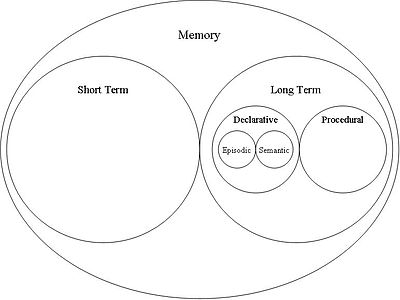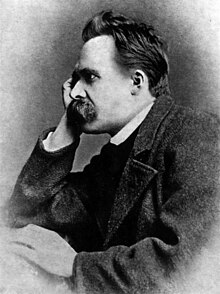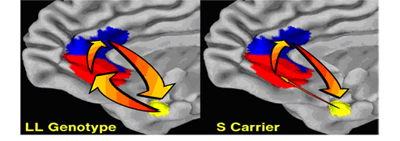Fundamentals of Neuroscience/Memory
Goalsedit
Types of memoryedit
Working and short-term memoryeditWorking memory, which lasts between several seconds to several minutes, can be generalized as an active and constant 'refreshing' of some experience. The brain circuits involved in expressing that experience remain in a constant loop of activity, thus keeping that experience 'in mind'. As an example, imagine that a picture is to be held in working memory. While that picture is still being viewed, then the brain circuit which is most active is a pathway from the occipital lobe where visual stimuli are first processed to parietal lobe sections where that visual information is converted into coherent, unified objects (i.e. the sight of black wheels plus sight of bright red paint plus sight of a ladder and hoses are bound together into the visual perception of a firetruck). When the picture is no longer present but is instead being actively recalled by working memory, essentially this same occipital to parietal pathway is being activated in a loop, so that the image remains consciously noted. Memory consolidation and long-term memoryeditA rough example of a looping neural network.
Long term memory, which lasts between minutes up to an entire lifetime, is slightly more complex, as it involves a period of consolidation and a series of crucial neurochemical changes. The first stage is memory consolidation, which takes place in the hippocampus. The hippocampus is the essential location for almost all memory consolidation, although it is important to note that most long-term memories are not stored there. The cellular mechanism responsible for memory formation is long term potentiation (LTP). To start, the information to be encoded is represented by a network of connections between neurons. The strength of these connections can vary or change over time, and it is this principle that allows LTP to occur. Synchronized firing among neurons in a network in response to being presented repeatedly with some stimulus strengthens the connections among those neurons. LTP is simply the neurochemical process of strengthening these connections (through the strengthening of the synapses between neurons). Thus, on a rudimentary level, the information memories contain is stored in the relative strength of the connections between neurons in a network. A network whose connections are very strong can be thought of as a strong or vivid memory, while those with weaker connections require more synchronized activation in order to become a lasting memory (which gives rise to the old cliche that practice (or repetition) makes perfect). The next stage of long-term memory is a period of consolidation where the networks strengthened in the hippocampus are 'moved' to their final storage destinations in the cortex. In the case of complex memories, each portion of that memory experience is theorized to be stored in the cortical region associated with that experience modality. So when remembering some event such as riding the train, the sounds one remembers hearing on the train ride are stored in auditory areas, the sights in visual areas, etc. Memory retrievaledit The basis of memory recall is a re-creation of that memory. As shown by the discussion of LTP in long-term memory, memories are stored as patterns of neural network activation across the brain, such that those networks encode the information of the event (information as in the sights, sounds, details, etc.). Once some sort of stimulus causes a part of one of these memory networks to become activated, the strength of the connections between members of that network cause the entire network to become activated too, thereby recalling the memory experience. In contrast to this full re-creation of the memory experience generated by complete activation of the memory network, partial activation of a network can lead to unconscious recognition or presque vu. An example of recognition would be seeing a picture of Friedrich Nietzsche, then from that remembering his name, some basic facts about his life, etc. In this example, the picture acts as the stimulus which can crudely be seen as activating some part of your 'Friedrich Nietzsche network'. If the strength of the connections in this network is strong, then this stimulus will cause the whole network to reactivate, thus accounting for your ability to recall facts about Nietzsche, such as what books he wrote, when he lived, etc. If these connections are not as strong, there may only be partial activation of the Nietzsche network, leading to moments where the person's name is on the 'tip of your tongue', and the only way to access it is to try to activate more of the network. For example, just seeing Nietzsch's face may not be enough to trigger recall of his name, but add to that some vague recollection of 19th century philosophers, something about the word Übermensch, and then suddenly there is enough of the 'Nietzsche network' activated to be able to retrieve his name. A secondary point which is worth mentioning is that because the brain is a dynamic, ever-changing system, memories are prone to be altered during recall. The reason behind this is that the memory network is being activated at the same time other networks are being activated by the present world. For example, you may recall a favorite camping trip you went on as a child at the same time you are happening to eat a graham cracker. If a neuron from the 'camping trip network' should form a strong connection during this time to a neuron associated with experiencing the graham cracker, then part of the experience of eating a graham cracker may accidentally fuse into the memory's network. So potentially years later when recalling that same camping trip, at the end you may distinctly remember eating graham crackers over the campfire, when in fact this never happened. | |||||
